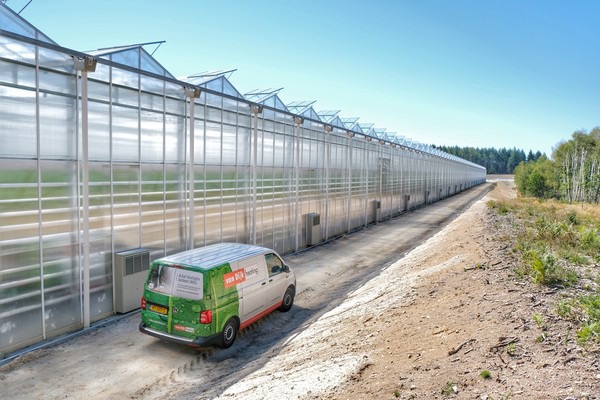Tomates d’Auitou is a young, sustainably designed plant nursery in the heart of France. Residual heat from a nearby power plant and Van Dijk Heating’s Active Ventilation System (AVS) play a key role in its climate control. “AVS supplies efficient moisture removal and a stable climate with low disease pressure,” grower Geoffrey Goutoule says. “It’s all about sustainable tomatoes and a small footprint.”
The sustainable tomato grower Tomates d’Auitou covers 5 hectares of substrate cultivation, which was built in two stages in 2020-2021 by the Dutch greenhouse builder HortiNed. This nursery is currently putting the finishing touches on the third phase, which covers 3 hectares. “It will remain at that for the time being,” says co-owner and CEO Geoffrey Goutoule. “We work in a challenging region, but the prospects for sustainable, locally grown tomatoes in France are good. Over the long term, expansion is certainly an option, provided it can be done sustainably.”

Residual heat
Tomates d’Auitou is located in the municipalities of Moustier Ventadour and Rosiers d’Egletons. The location surfaced during a search for a sustainable heat source, so the company wouldn’t need to use fossil fuels.
“The power plant in Rosiers d’Egletons already had facilities to supply third parties with the residual heat released during electricity production, but nothing had been done with that in 2019,” the entrepreneur explains. “The energy utility and the authorities were keen to work with us on our plans, which also provided for compensation for the environmental resources that would be lost during construction. It worked out well for all of us.”
Cascade principle
The hot water supplied by the power plant arrives at a temperature of 50°C. Growth pipes and pipe rail heating (Ø 51 mm) transfer the heat according to the cascade principle to the cultivation areas, which are equipped with two screen systems. In the end facades, there are AVS air handling units for active ventilation, which are also connected to the heat network. Additionally, Tomates d’Auitou has a small gas boiler, which essentially only runs to make it easier to melt snow on the greenhouse roof. “We are 600 meters above sea level here on the edge of the Central Massif, so it can snow quite a bit here,” the grower explains.

Geoffrey Goutoule
Moisture removal and homogeneous climate
The AVS units are used to circulate greenhouse air internally and to mix greenhouse air with relatively dry outside air that is drawn in and preheated in the AVS, in order to remove moisture from the greenhouse. Goutoule: “Moisture drainage and a homogeneous greenhouse climate with minimal loss of heat and CO2 were the main reasons for choosing AVS. We’re very happy with this system.”
In construction phases 1 and 2, the French owners opted for an AVS-5000 configuration, which boiled down to one unit for every eight rows of plants.
Higher capacity
The grower: "Van Dijk Heating recommended one unit for every five plant rows, and a larger ventilation capacity does indeed seem better. The heat available at our company is almost exclusively low-grade. This means you have to create sufficient air circulation to keep the crop active. For phase 3, in consultation with Van Dijk and HortiNed, we have chosen a slightly larger AVS-7000 unit, but we are still sticking to one unit per eight plant rows for a while. The plan is to double the number of units in a few years to one per four planting rows."
This offers several advantages. The control range becomes substantially larger, while the fans can run at lower speeds at lower energy costs. "By then, our greenhouse will have quite similar characteristics as a semi-closed greenhouse, in which you can grow tomatoes very efficiently. An additional advantage is that Botrytis will then cause even fewer problems."
For more information:
Van Dijk heating
+31(0)30 656 38 44
[email protected]
www.vandijkheating.com
